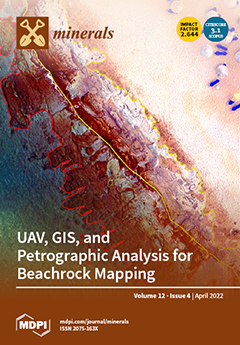The main aim of this paper is to study the cation fixation sites in montmorillonite after heating at different temperatures. Montmorillonite was used to adsorb cations (Na
+, Cu
2+ and Li
+) in the solution, and the montmorillonite-adsorbed cations were heated at different temperatures (unheated, 100 °C, 200 °C and 300 °C) for 25 h. Subsequently, the basal spacing of montmorillonite treated at different temperatures was monitored by X-ray diffraction (XRD). The exchangeable cationic content (Na
+, Cu
2+ and Li
+) in montmorillonite was determined based on an inductively coupled plasma emission spectrometer (ICP-OES). In addition, the stretching and bending vibration changes in the OH group and the Si-O bond in montmorillonite were detected by Fourier transform infrared spectroscopy (FTIR). The vibration changes were related to the cation fixation sites. The XRD data showed that when the heating temperature reached 200 °C, the structure of montmorillonite adsorbing Li
+ and Cu
2+ ions completely collapsed, but the layer spacing of montmorillonite adsorbing Na
+ decreased slightly, which indicated that Li
+ and Cu
2+ were more easily able to enter the crystal structure. The ICP-OES results showed that the contents of exchangeable Na
+, Cu
2+ and Li
+ in montmorillonite decreased with the increase in heating temperature, and Li
+ was more easily fixed by montmorillonite than Na
+ and Cu
2+. The FTIR data showed that when montmorillonite adsorbed with Li
+ was heated at more than 200 °C, a new OH stretching vibration band appeared at 3971 cm
−1, which may be caused by the migration of Li
+ into the octahedral vacancy to form a local trioctahedral structure. Na
+ has a large radius; it can only be fixed near the OH group and may not enter the tetrahedron/octahedron of montmorillonite. The number of charges carried by Cu
2+ is high and the dehydration enthalpy of hydrated Cu
2+ is high. When the heating temperature was greater than 200 °C, Cu
2+ mainly entered the hexagonal cavity of the tetrahedron and caused slight changes in the OH bending vibration. The vibration of the Si-O bond hardly changed after montmorillonite adsorbed Na
+, but the stretching vibration peak of the Si-O bond moved to the high value region after adsorbing Cu
2+ and Li
+, which was speculated to be related to the migration of Cu
2+ and Li
+ into the crystal structure.
Full article





